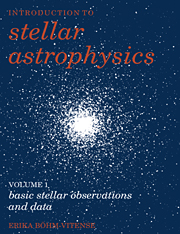Book contents
- Frontmatter
- Contents
- Preface
- 1 Positions of stars
- 2 Proper motions of stars
- 3 Distances of nearby stars
- 4 The brightnesses of the stars
- 5 Color magnitude diagrams
- 6 The luminosities of the stars
- 7 Angular radii of stars
- 8 Effective temperatures of stars
- 9 Masses and radii of stars
- 10 Spectral classification
- 11 Understanding stellar spectra
- 12 Population II stars
- 13 Stellar rotation
- 14 Stellar magnetic fields
- 15 Stars with peculiar spectra
- 16 Pulsating stars
- 17 Explosive stars
- 18 Our sun
- 19 Interstellar absorption
- Appendixes
- References
- Index
- Frontmatter
- Contents
- Preface
- 1 Positions of stars
- 2 Proper motions of stars
- 3 Distances of nearby stars
- 4 The brightnesses of the stars
- 5 Color magnitude diagrams
- 6 The luminosities of the stars
- 7 Angular radii of stars
- 8 Effective temperatures of stars
- 9 Masses and radii of stars
- 10 Spectral classification
- 11 Understanding stellar spectra
- 12 Population II stars
- 13 Stellar rotation
- 14 Stellar magnetic fields
- 15 Stars with peculiar spectra
- 16 Pulsating stars
- 17 Explosive stars
- 18 Our sun
- 19 Interstellar absorption
- Appendixes
- References
- Index
Summary
Introduction
The sun is, of course, the star nearest to us and is, therefore, the best studied star. We have mentioned the sun several times as an example when we talked about distances of stars, effective temperatures and masses of stars, as well as angular radii. For all these studies we considered the sun to be just one of the normal stars, which it most probably is. It is the most thoroughly studied normal star. The sun is also the only star for which we can get high spatial resolution, which enables us to observe fine details on the surface which we will not be able to observe on other stars, at least not in the foreseeable future. These high spatial resolution studies of the sun reveal many features and processes which may well be also going on in other stars, but which we are not able to study in any other celestial object. Some of these features are the solar chromosphere and corona, though ultraviolet observations by means of satellites now permit us also to study global properties of these outer layers of stars other than the sun.
Another such phenomenon, which we can study in detail only in the sun, is the solar activity, which means flares, sunspots, and the whole solar cycle of activities. Again, observations with very high resolution and very sensitive receivers now permit us to study global effects of activity in other stars which seem to show activities similar to the sun.
- Type
- Chapter
- Information
- Introduction to Stellar Astrophysics , pp. 193 - 212Publisher: Cambridge University PressPrint publication year: 1989

